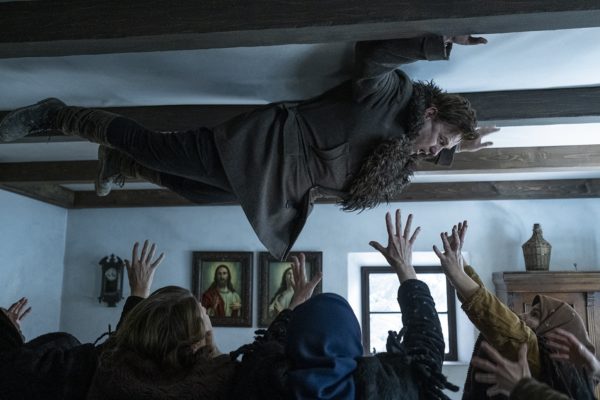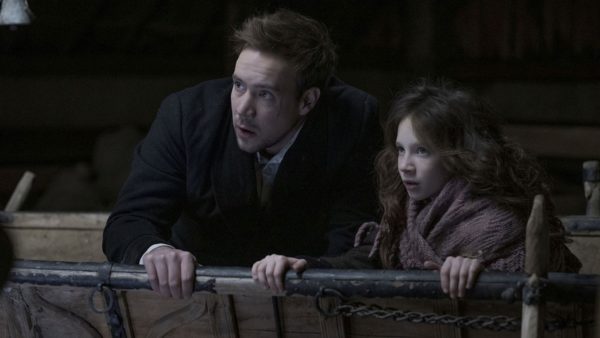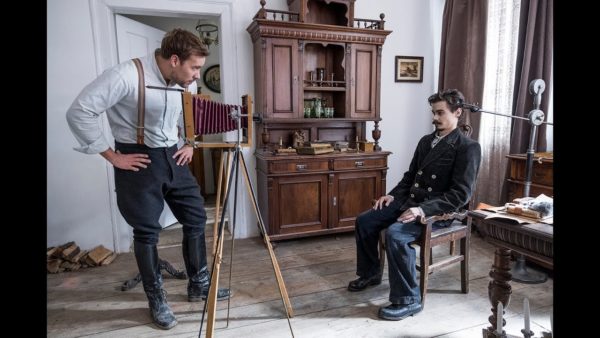
Post Mortem (2020), Hungary’s submission for the Best Foreign Language Oscar, is a visual spectacle about a small town caught in the throes of ghostly attacks.
The film follows Tomás (Viktor Klem), a soldier left for dead after the first world war who begins touring with carnival-esque show. Tomás’ contribution to the show are post mortem photos: staged family portraits of the dead. One day at the market, he befriends orphaned pre-teen Anna (Fruzsina Hais), who comes from a small town nearby where most of the young men have died in the war, while others have died from Spanish flu.
Post Mortem actually opens with Tomás’ vision of Anna hovering above him, her hair backlit by flames. This image recurs throughout the film and helps to establish the film’s supernatural vibe while simultaneously creating a connection between the pair. The photographer agrees to accompany her back to the village, but he’s almost immediately confronted with spooky events: his suitcase sinks into the wet ground, he hears footsteps in the deserted attic and, most unnervingly, dark figures lurk behind the dead in his developed photos.
Most of these early supernatural occurrences in Piros Zánkay’s screenplay feel familiar, which create a (false) sense that the film is playing by a well-established rule book. This is especially true of the visual iconography of the black figures, who look like smoky/inky cut-outs as they crawl around roofs and ceilings. It is only when the ghosts become more aggressive and townspeople begin to die that Post Mortem breaks new ground.
One of the film’s biggest selling features is its stunt work and visual effects. Despite being made for only $2.8 million US, director Péter Bergendy stretches his budget to include not just period authentic sets and costumes, but a bevy of truly spectacular FX (there’s ~25 credits for the visual effects team alone). The ghosts manipulate not just inanimate objects, but people, too: characters are routinely dragged across the ground, lifted into the air and left to dangle upside down by invisible forces. While the effect could look hokey, the results here are great; it’s unnerving and exciting, particularly when other characters are powerless to prevent the attacks.

If there is one area that proves underwhelming, it’s the overall story, which is a little threadbare, as well as the central relationship between Tomás and Anna. While the pair obviously share a connection and a great deal of affection for each other, it’s highly unusual that a 10 year old girl is allowed to spend all of her time with a strange man, particularly in scenarios fraught with danger. Post Mortem makes it clear that Anna is mature, and her guardian, Auntie (Andrea Ladányi) is an elderly woman confined to a wheelchair who is looked after more by Anna than the other way around, but nevertheless there’s an discomforting feeling in the surrogate father/daughter relationship that grounds the whole film.
Besides this, there simply isn’t that much story in Post Mortem, which is an issue when the film is nearly two hours. The middle section, which transforms Tomás and Anna into ghost hunters who interview townspeople, lay traps and review evidence, is a bit saggy, though it’s never dull thanks to unusual details, such as the visually striking sight of superstitious men walking around town wearing burlap sacks over their heads for protection against spirits.
Aside from Tomás, Anna and Auntie, the cast is relatively small: there’s comely Marcsa (Judit Schell) whose home Tomás stays in and with whom he develops an intimacy that Zánkay seems uncertain about developing. There’s also a pair of near-mute twins (Tamás Miklós Hajdu and Kristóf Mucsi) who assist the investigation when the other townspeople start avoiding Tomás, fearing he is responsible for the attacks.

The escalation of ghostly activity leads to some terrifically exciting sequences, including a stake-out in a barn full of bodies, rigged up with bells and cameras to capture sound and movement. As the cacophony of bells and camera flashes escalates, a young boy using a rope line to find his way home in the dark outside is attacked and dragged away by invisible forces.
This sequence is immediately succeeded by a broad daylight attack as townspeople are randomly plucked into the air as hysterical onlookers scream, panic and try to pull them down. It’s a bravado sequence, augmented by the superb work of the visual effects team.
Despite being light on story and featuring an uncomfortable surrogate father/daughter relationship, Post Mortem is beautiful and haunting. Featuring top notch visual effects and stunt work, this Hungarian horror film features no shortage of memorable sequences, particularly in its exciting back half. 3.5/5
Post Mortem played at the 2021 Toronto After Dark Film Festival